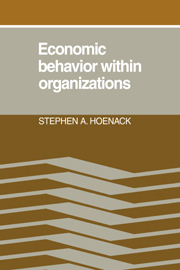Book contents
- Frontmatter
- Contents
- Preface
- 1 Introduction
- 2 Definitions and determinants of employees' discretion over an organization's resources and production
- 3 Employees' resource diversions and employers' imposition of resource responsibility
- 4 Short-run resource allocation under fixed budgets
- 5 Short-run resource allocation in response to demand: the cases of an employee, a private corporation, and a private nonprofit organization
- 6 Legislative demand and short-run price and output of the public organization
- 7 Employees' investment behavior and implications for suborganization
- 8 Equilibrium behavior of public and private organizations in the first long run
- 9 The demand and supply of nonmarket resource allocation
- 10 A brief summary and proposed directions for further work
- Notes
- References
- Core definitions
- Index
2 - Definitions and determinants of employees' discretion over an organization's resources and production
Published online by Cambridge University Press: 05 November 2011
- Frontmatter
- Contents
- Preface
- 1 Introduction
- 2 Definitions and determinants of employees' discretion over an organization's resources and production
- 3 Employees' resource diversions and employers' imposition of resource responsibility
- 4 Short-run resource allocation under fixed budgets
- 5 Short-run resource allocation in response to demand: the cases of an employee, a private corporation, and a private nonprofit organization
- 6 Legislative demand and short-run price and output of the public organization
- 7 Employees' investment behavior and implications for suborganization
- 8 Equilibrium behavior of public and private organizations in the first long run
- 9 The demand and supply of nonmarket resource allocation
- 10 A brief summary and proposed directions for further work
- Notes
- References
- Core definitions
- Index
Summary
The discretion that employees hold over an organization's productive activity and the incentives that they face determine the ways resources are allocated within an organization. This chapter examines the nature and range of employees' discretion by considering the influence delegated to them over the applications of inputs and choices of outputs within the organization's production functions. We first examine these production functions and define an employee's “production domain.” Considered next are the relative costs to an employee and other interested parties of information about his production domain and the concepts of externally and internally designed production domains. Finally, we explore the conditions under which production domains are externally and internally designed.
An organization's production functions, its production domains, and its employees' discretion over resource substitutions
In order to analyze the motivation for delegating discretion to employees over an organization's resource allocation, it is necessary first to consider the nature of the production functions that an organization encompasses. We can then specify an employee's discretion in terms of his influence over possible resource substitutions within these production functions.
Production functions
Organizations usually produce many intermediate and final outputs. The rate of production of each of these outputs can typically be achieved in different ways, that is, with alternative rates of application of the various inputs which can contribute to each output. A production function expresses the set of known technologically feasible ways of transforming inputs into one or more outputs.
- Type
- Chapter
- Information
- Economic Behaviour within Organizations , pp. 16 - 33Publisher: Cambridge University PressPrint publication year: 1983



